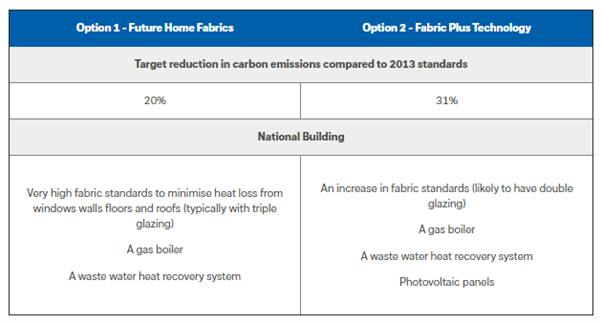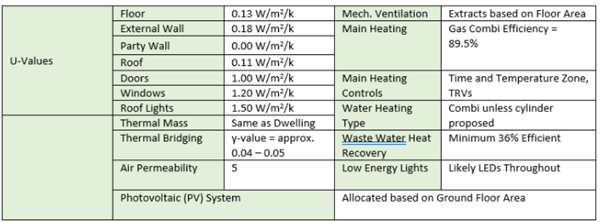The new Future Homes Standard is set to be introduced by 2025 and the latest update for consultation was on the 19th of January 2021. The UK Government aims that all newly constructed and newly renovated buildings - domestic dwellings and other buildings - are highly energy-efficient. This will in turn reduce CO2 emissions which will help achieve ‘Net Zero’ by 2050.
How the Future Homes Standard will be achieved is by one of 2 methods:
Future Homes Fabric: a 20% efficiency improvement on current standards in terms of U-Value of heat-transmitting materials in the home
Fabric Plus Technology: a 31% improvement on current standards focusing on low-carbon technology covering heating and renewables

SAP 10
SAP 10 is the methodology used to show compliance with Part L but is still to be BRE approved. However, reviewing the two options aforementioned of the Future Homes Standards and the reference values stated below, should provide an insight into how compliance is achieved.

The U-value or thermal transmittance is the rate of transfer of heat through a structure divided by the difference in temperature across that structure. The units of measurement are W/m²K. The better insulated a structure is, the lower the U-value will be. Important to note that heat transfer is closely related to CO2 emissions as more CO2 is generated to replace heat lost within a building thus less heat transfer – less CO2. Currently, to comply with Part L, the Dwelling Emission Rate (DER) is to be no higher than the Target Emission Rate (TER). The Dwelling Fabric Energy Efficiency (DFEE) is to be no higher than Target Fabric Energy Efficiency (TFEE). In the next version of Part L, whether option one or option two is adopted, there will be new compliance measures:
DER no higher than the TER
Dwelling Primary Energy Rate (DPER) no higher than the Target Primary Energy Rate (TPER)
The Target Emission Rate (TER) & the Target Primary Energy rate (TPER) values in which efficiency standards are measured will incorporate PV systems. As a result, to achieve a Dwelling Emission Rate (DER) and Dwelling Primary Energy Rate (DPER) no higher than their target values it is expected that most new dwellings under the Fabric Plus Technology method, will require some form of Solar PV or low carbon technology, such as a heat pump.
Timeframe
The original intention was for one of these options to be introduced into the Building Regulations in 2020. The latest expectation is that Part L will be released in October 2021 to come into effect in April 2022, but still to be confirmed. If the Government opt for the Fabric Plus Technology option – it will mean that installing Solar PV can help architects, builders and installers reach the standards required.
Summary
Although there is no official release date for new Part L regulations. There is enough information within the latest SAP 10 methodology to indicate a certain level of compliance to be expected. This is where developers will be able to determine where gains and shortfalls are evident and how to plan accordingly.
The two available options (option 1 Fabric or option 2 Fabric Plus Technology) will require further considerations and official recognition by the BRE. Implementation of the newly suggested regulations within the Governments own timeframe is questionable due to several factors such as the global pandemic, Brexit and the Government missing their own consultation deadlines. But what is certain is that if the Fabric Plus Technology methodology is adopted - cost-efficient Solar PV is a sure-fire way to help reach the targets set out to meet the standards, reduce CO2 emissions and take a giant leap towards Net Zero 2050.
